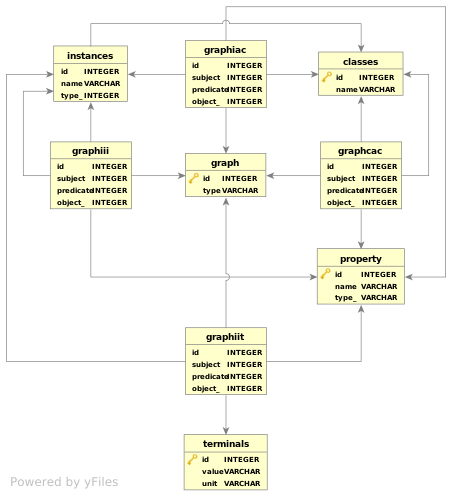So, first two weeks of my GSoC have been completed.
My project is basically on improving the Hydra server in Python called hydrus.
My first task was to improve the existing database architecture that hydrus used internally while serving any ApiDoc.
This task was related to this issue.
The existing schema:

This design for the database was really generic.
Our aim was to have a database multi-table architecture where different resources are stored in different tables to improve scalability and efficiency. The result we wanted to achieve was that there will be should be a table for each hydra:Class and hydra:Collection defined in the ApiDoc.
For example, if we consider the Drone ApiDoc, we would want a State table, Drone table and so on. The columns would be the properties defined under the supportedProperty for that Class or collection.
This would easily facilitate the operations on the data as for any operation such as updating a new record or deleting a old record, we would just need to call the methods provided by Flask-SQLAlchemy library. A lot of overhead which we had in our previous database schema would be minimised.
For example, in the previous database schema, for a simple operation such as adding a Message Instance, (by doing a PUT request to /MessageCollection) , we would need to do an INSERT operation in 4 tables, namely the instance table, terminals table, graphiit table, graph table. That is not that efficient.
In the new schema, there will be a separate table for storing all instances of Message class. This table will have a primary key column and a column with name MessageString (from the supportedProperty of Message class). So, to modify any instance of Message class, we will only need to do a single operation on this on table.
This will make our database operations much more efficient.
To achieve this feat, I had to read the ApiDoc and then make the database specific to that ApiDoc.
I had spent the first week reading on hydrus‘s existing schema and understanding on how we are storing the data. This made it more clear to me on how I could optimize the database architecture.
In the second week, I had started implementing the logic for parsing the ApiDoc and making the tables from reading that. I have completed till making the tables “dynamically”.
In the next week, I will look into how we can get ‘linking’ behaviour in the tables, meaning how would we connect tables with foreign keys by just parsing the ApiDoc.
The work I have done is in this PR: https://github.com/HTTP-APIs/hydrus/pull/479
Learnings
I learnt a lot on how we go about database optimisation.
I also learnt how to “dynamically” create tables in a database using Flask-SQLAlchemy library. The challange was mainly to create Python classes on runtime. Because all the operations on the tables will be done from SQLAlchemy classes.
Surprisingly, Python’s unasumming type function was the backbone for making classes on runtime.
This blog post also came very handy.